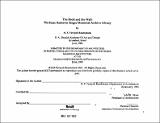| dc.contributor.advisor | John R. Myer. | en_US |
| dc.contributor.author | Rosenstock, H. F. Tzviyah | en_US |
| dc.contributor.other | Massachusetts Institute of Technology. Dept. of Architecture. | en_US |
| dc.date.accessioned | 2012-03-16T15:58:46Z | |
| dc.date.available | 2012-03-16T15:58:46Z | |
| dc.date.copyright | 1993 | en_US |
| dc.date.issued | 1993 | en_US |
| dc.identifier.uri | http://hdl.handle.net/1721.1/69729 | |
| dc.description | Thesis (M. Arch.)--Massachusetts Institute of Technology, Dept. of Architecture, 1993. | en_US |
| dc.description | Includes bibliographical references (p. 85-88). | en_US |
| dc.description.abstract | The design of this library is based upon two architectural concepts: the concept of defensive architecture, which is the architectural response to perceived threat, and the concept of the building as metaphysical model of the universe, having domains of sacred and profane space. I have long been intrigued by defensive architecture, by the forms it generates in response to perceived threat. The towers, mask-like facades, and labyrinthine passageways remain intriguing long after the war is over. Castles and fortifications are the architectural manifestation of an abrupt discontinuity in the organization of space. A stark polarity is created, a partition between inside and out, ours and theirs, us and them. The stark form of a defensive structure derives enormous formal power from this conflict of opposites. Tamer, gentler forms of this concept may be found in the form of monasteries, and madrasas. These share the qualities of retreat and seclusion, but for a different purpose - to be able to concentrate better on learning, and/or prayer. Their seclusion from the outside world is not a hostile act but rather a desire to intensify their inner world of prayer and study. These building types share qualities of having walls which segregate opposing conditions, as in defensive architecture, but differ in that the thing being excluded from the protected domain are of a spiritual nature, rather than physical threats. Sacred space is a domain generated by an origin which marks a vertical break in space from the ordinary ... | en_US |
| dc.description.statementofresponsibility | by H.F. Tzviyah Rosenstock. | en_US |
| dc.format.extent | 88 p. | en_US |
| dc.language.iso | eng | en_US |
| dc.publisher | Massachusetts Institute of Technology | en_US |
| dc.rights | M.I.T. theses are protected by
copyright. They may be viewed from this source for any purpose, but
reproduction or distribution in any format is prohibited without written
permission. See provided URL for inquiries about permission. | en_US |
| dc.rights.uri | http://dspace.mit.edu/handle/1721.1/7582 | en_US |
| dc.subject | Architecture. | en_US |
| dc.title | The book and the wall : the Isaac Bashevis Singer Memorial Archive Library | en_US |
| dc.title.alternative | Isaac Bashevis Singer Memorial Archive Library | en_US |
| dc.type | Thesis | en_US |
| dc.description.degree | M.Arch. | en_US |
| dc.contributor.department | Massachusetts Institute of Technology. Department of Architecture | |
| dc.identifier.oclc | 28738760 | en_US |
